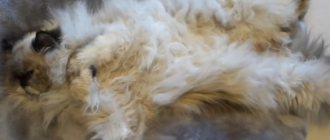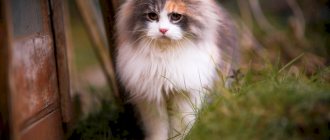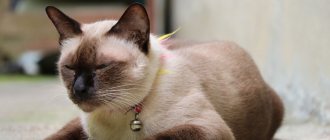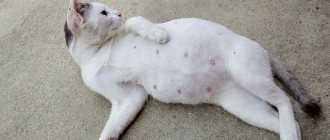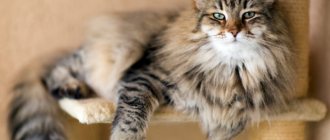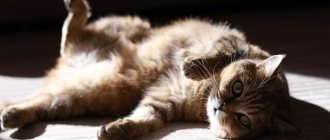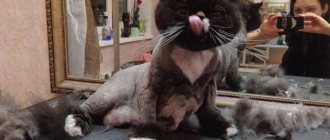A cat's fur is one of the indicators of its health and proper maintenance. The beautiful, smooth, shiny coat of a pet is the pride of the owner, especially if it participates in exhibitions.
The appearance of mats (matted dense balls of hair) indicates insufficient daily care or other problems for the pet. More often, cats of long-haired breeds (Persian, Maine Coon, Neva Masquerade, Turkish Angora, Siberian, Burmese, Norwegian Forest) suffer from this, since these animals cannot fully care for their thick and long hair. In cats of short-haired breeds, tangles can appear when sticky or adhesive substances come into contact with the fur: resin, varnish, paint, etc.
What are mats?
The fur of cats, especially long-haired breeds, requires careful care. With a lack of hygiene, poor nutrition and other mistakes when keeping pets, their fur begins to deteriorate. This affects not only appearance, but also health.
Older pets cannot provide themselves with the same careful care as younger pets. The wool begins to get tangled, matted, and tangles form. However, young age is not a guarantee that lumps will not appear.
Bathing and brushing long-haired pets - five basic rules
Your pet needs to be washed every month or when it gets dirty. But the owner should not get carried away with this procedure; after all, water procedures for furry pets are stressful.
Before swimming, be sure to close all windows to prevent drafts. The water must be heated to a temperature of 38° C. Before the procedures, the cat must be prepared: cover the ears with cotton swabs, thereby protecting them from water. To dry the fur, wrap your cat in a warm terry towel for a few minutes.
After the procedure, it is better not to touch the pet and leave it alone for a while. Another important point is that after vaccination, cats should not be bathed for two weeks.
To brush a cat, you need the following tools: a brush with natural bristles, a metal comb, a slicker brush, scissors with safety tips, powder or spray. It is best to comb the fur on the paws and face using a slicker brush. And for the body, use combs with different numbers of teeth. Either carefully comb the tangles or cut them off.
You should start brushing your cat from the head, then move on to the neck, back, sides, chest, belly, hind legs, front legs and tail. Use a soft bristle brush first and then a comb. If the wool has a large number of tangles, then use a wide-tooth comb first, and only then a soft brush. During combing procedures, you can use talc, so the animal’s fur will be less tangled.
To summarize, we can conclude that successful washing and combing depends on the following five important rules:
- When bathing, use products with natural ingredients; they will not dry out the animal’s skin and will give the coat a healthy, shiny appearance. After application, rinse thoroughly with water.
- You can bathe your cat in a special cotton bag, but the head should remain outside. Such manipulations will allow you to control the cat's movements and protect yourself from scratches and bites.
- For combing, use special metal tools; plastic combs cause the long hair of pets to become highly electrified.
- Use a specialized antistatic spray (only for cats over 1 year old). The coat will become obedient and smooth.
- When bathing and brushing, act carefully and be sure to positively reinforce the animal. Having formed a positive attitude towards hygiene procedures in kittens, your pet will begin to truly enjoy them, and the process of bathing and brushing will bring joy to both of you.
Causes
If pets are healthy and can take care of their hygiene, they usually do not develop tangles. However, there are cat breeds with fluffy fur and thick undercoat that are prone to ball formation. These include Persians, British, Turkish Angora and others.
Not all long-haired breeds suffer from mats. For example, Siberian cats and Maine Coons rarely develop lumps. Mainly in places of thick and wavy undercoat (on the “collar”, “pants”).
Mats on wool appear for the following reasons:
- the pet is rarely or not brushed at all;
- during the molting period, the animal’s old fur is not combed out;
- the pet is sick;
- the cat is washed with an incorrectly selected shampoo; when soaping, the fur becomes very crumpled, which is why dense clumps are formed;
- the cat is lazy and fat, obese;
- the pet does not eat rationally, which is why it may develop vitamin deficiency (the fur becomes very loose and the risk of lumps forming increases);
- sticky substances (for example, jam, honey, paint, etc.) have come into contact with the fur;
- pathological conditions develop: oncology, parasites, dermatitis, endocrine disorders.
If a pet develops tangles, the owner is to blame. This means he did not take good care of the animal.
Preventing problems with your cat's coat
Preventive measures for any fluffy long-haired cats, in particular Maine Coons, Siberians, Angoras and Persians, include the following simple rules:
Read also: Why is there a weak spark on a scooter ~
- Brush the animal at least once a week (Persians are scratched more often, sometimes every day).
- To untangle the hair knot, use a special spray.
- When combing your cat's coat, use a comb with round toothed ends so as not to injure the cat.
- When shedding, be sure to remove loose hair using a slicker. At other times, this tool should not be used.
- In extreme heat at the dacha or at home, a very “shaggy” cat should be trimmed. This will not only prevent tangles, but also protect it from overheating and heat stroke.
- Sometimes, to stop the formation of mats, you need to change the cat's food or add a little more fats and vitamins.
A good owner monitors the health of his pet and its appearance. Small fur seals need to be eliminated immediately, then there will be no need for labor-intensive removal of tangles. Simple brushing takes no more than five minutes a day, brings a lot of pleasure to the animal when done correctly and protects it from painful formations in its luxurious fluffy fur.
Why are they dangerous?
The appearance of matted fur spoils the appearance of the animal. This is a huge disadvantage for a breeder of purebred cats. In addition, petting a pet with mats is unpleasant.
However, these are not the worst consequences. Mats can provoke the development of various diseases. Pathogenic microorganisms begin to multiply in matted wool. When a pet licks itself, they enter the body and continue their synthesis there.
Fleas, lice, ticks and other parasites take root well in tangles. The skin under the lumps becomes rotten, dermatological problems arise that are difficult to treat. In addition, the cat will try to independently remove matted fur with its claws, and in the process may cause wounds to itself. Such damage will take a long time to heal.
Why is a haircut completely or partially undesirable?
Nowadays cat haircuts are gaining popularity. Paying tribute to fashion, owners forget that this is not at all useful for their pet, and sometimes even dangerous. Veterinarians unanimously say that cats can be cut only in case of urgent need: for various skin diseases, in the presence of serious mats in cats, and also in preparation for surgery.
The structure of the coat changes after grooming: the newly grown one becomes thinner, matted areas quickly form ꟷ in this case, the solution again will be to trim the cats’ mats. In some areas the fur does not grow back or takes too long to grow. As a result, the animal’s skin also suffers - it becomes less elastic and elastic, and body temperature decreases. All this can lead to serious illnesses.
Animals have an extremely negative attitude towards the grooming process itself and its result. There are cases of cats trying to injure themselves after being groomed.
Grooming also disrupts thermoregulation - some cats even in the hot summer begin to freeze after a grooming. What can we say about the cold winter? A short-haired cat simply will not move away from the battery.
There is a less serious, but quite important reason for owners of purebred cats, why they should refuse haircuts. The fact is that the appearance of the animal undergoes changes, the fur changes and may begin to curl. Such a cat will no longer be appreciated at an exhibition. Before you cut your pet's hair completely or partially, think about whether your pet needs a change of appearance - or if it's just your whim.
Removal methods
Tangles are removed from wool in the following ways:
- If the lumps are small, you can comb them out. The pet should be placed on its side and stroked. This is necessary so that he calms down and does not break out. First, comb the sides and back, neck and chest, forelimbs, tail. It is more difficult to get rid of tangles on the stomach and hind legs. Most likely the animal will bite.
- Large clumps are recommended to be cut lengthwise and then combed.
- If there are a lot of tangles, it is completely impossible to comb them out, then the tangled hair will have to be cut to the ground. You need to be very careful: a cat’s skin is thin and can be easily damaged. Clumps can be removed with scissors, people clippers or hair clippers. The receding hairline will heal after a few months.
- At the pet store you can purchase a special device called a tangle cutter. This is a comb with blunt ends, blades between the teeth.
- You can take your cat to a veterinarian or pet groomer. There your pet will be trimmed at an affordable cost.
- To deal with long unnecessary hair, there is a special comb - a furminator. Not only will it help get rid of clumps, but it will also be an indispensable tool for daily combing.
Contact a specialist
If the trichomes are so dense that combing is a waste of time, you should treat the overgrown pet at a groomer. The procedure is also carried out in a veterinary clinic. The wool is completely shorn. In some cases, it is possible to trim a cat decoratively if the body is not completely covered with lumps.
An experienced owner can carry out a complete haircut himself. The procedure allows you to quickly and painlessly relieve your pet of painful lumps.
In a grooming salon, to trim a cat's fur from tangles, they usually use clippers with attachments of 2 mm or more, which do not injure the cat's skin. Before the procedure, the animal is fixed or euthanized (taking into account the neglect of the situation).
Rules for removing mats in cats
Recommendations for removing mats:
- The process of eliminating lumps is long. Most likely, your pet will not like it. The pet will not give in and will start fighting. Therefore, it is better to comb out tangles together: one person holds the cat, the other combs it. If the animal is very nervous, then it is better not to traumatize its psyche and get rid of the matted fur not at once, but several times.
- Only areas with long hair are clipped. It is better not to touch the paws and head. It's okay if your pet looks like a lion. The fur will grow back in a couple of months.
- Until the mats are removed, washing the animal is prohibited. After water, lumps are more difficult to comb out.
- After combing, treat the pet's fur with an antistatic spray. The product will detangle your hair and prevent further formation of tangles.
How to care for a clipped cat?
After grooming, the cat needs to be bathed to remove any remaining hair that may cause discomfort. The animal needs to be additionally combed, finally removing all the fallen fibers. The final stage will be treating the fur coat with an antistatic spray.
It must be remembered that an animal that has lost a lot of fur may behave strangely: most cats do not lie down, since a short coat causes unusual sensations. Pets refuse communication, food, and hunt for their tail. As a rule, after 2-3 days the behavior becomes the same
Animal psychologists recommend not to laugh at the cat and not to show excessive attention to its fur - the animal is very worried about its appearance and may be offended
A groomed pet needs to be provided with a house, blanket or other place where it can warm up. He should be rewarded with treats and petted frequently if he agrees to be handled. You need to prepare for the fact that after a radical haircut, the guard coat may change color.
Preventive measures
To prevent tangles from appearing, you need to take care of your pet. A cat needs to have its fur brushed at least once a day for 10-15 minutes. This can be done with different devices: a comb for fluff, for undercoat, massage combs, a combing device - a furminator (a combing device that allows you to quickly and easily remove dead hair).
When it's hot outside, you can give your pet a haircut. This can be difficult, so it's best to take your cat to the vet. When bathing your beloved pet, it is better to use a suitable shampoo that will make the coat silky, for example, Perfect Coat 8 in 1, “Luxury Lioness”, “Biovax”, Herba Vitae. After the animal has been bathed, it should be combed thoroughly, and if it is not afraid of a hairdryer, dry it.
It is important! The coat should be brushed at least 2 times a week. Some cats get used to being brushed and begin to treat the procedure as a session of pleasure.
It is important to pay attention to the choice of comb - it should not have hard teeth
A cat can recognize its illness itself and will try to fight it and comb out the tangles in every possible way, but only the pet’s owner will help remove them efficiently. The main thing is to accustom your furry friend to such a mandatory procedure, then over time he will get used to it and will not resist
A healthy coat is very important for your pet's well-being.
For information on how to cut mats using a clipper, see below.
